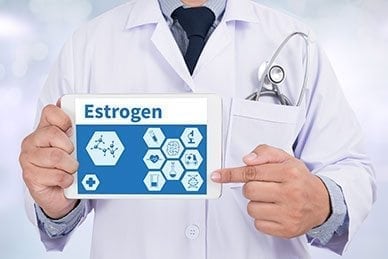Estrogen Regulates Fear Response in Women, Says New Study
While the role of estrogen in female development and reproduction is well-known, a new study indicates it may also help protect the brains of women from trauma. Existing studies have already suggested that women are more susceptible to post-traumatic stress disorder (PTSD) than men, despite experiencing fewer traumatic events. The new study suggests that estrogen regulates fear response in the brain by affecting how different areas of the brain respond to stress.
How Estrogen Regulates Fear Response
 Previous research has found that women who have suffered trauma experience more flashback episodes during the mid-luteal phase of the menstrual cycle, which occurs about a week after ovulation when estrogen levels drop. A new study published in Molecular Psychiatry set out to investigate how estrogen affects gene activity in the brain.
Previous research has found that women who have suffered trauma experience more flashback episodes during the mid-luteal phase of the menstrual cycle, which occurs about a week after ovulation when estrogen levels drop. A new study published in Molecular Psychiatry set out to investigate how estrogen affects gene activity in the brain.
Researchers studied blood samples from almost 300 women enrolled in the Grady Trauma Project (GTP), a study investigating the role of environmental and genetic factors in PTSD development among low-income African-American women. The team approached women in the study of childbearing and menopausal age who had suffered abuse or violence and asked them to participate in the new study with an interview and blood tests.
During the childbearing years, a woman's estrogen levels increase and decline based on their menstrual cycle, while menopausal and postmenopausal women have lower estrogen levels.
The researchers found that levels of serum estradiol, a form of estrogen, were associated with DNA methylation, a mechanism that modifies the DNA to suggest some genes get turned off.
By looking at estrogen-modulated sites that are also associated with PTSD, the team found a single gene associated with the brain's fear response that is affected by estrogen. The site is located in HDAC4, a gene that is involved in long-term memory formation, behavior and learning. Researchers found that methylation of the HDAC4 gene was significantly higher in PTSD patients than in control patients, and it was correlated with lower estrogen levels.
Estrogen and Anxiety
Previous research has also established the role of estrogen on the brain and anxiety in particular. According to a study conducted by neuroscientists at Harvard and Emory University, low estrogen levels increase a woman's vulnerability to trauma at certain points in their menstrual cycle, but high estrogen levels offer partial protection from emotional trauma.
 Women already have anxiety and depression rates twice as high as men, but the reason for the difference is still unclear. As study author Mohammed Milad put it, "PTSD is a disorder of recovery." It's possible men are at lower risk of PTSD because testosterone is converted to estrogen in male brains and remains more stable in their brains than in women's.
Women already have anxiety and depression rates twice as high as men, but the reason for the difference is still unclear. As study author Mohammed Milad put it, "PTSD is a disorder of recovery." It's possible men are at lower risk of PTSD because testosterone is converted to estrogen in male brains and remains more stable in their brains than in women's.
The Harvard researchers found that estrogen soothes the fear response in healthy women. The team also found that the higher the estrogen levels in women with PTSD who were trained on a fear-extinction task, the less likely they were to become startled.
PTSD is believed to affect up to 30 percent of women at some point with symptoms that last four times as long in women than in men. Because birth control medication can affect estrogen levels, these studies show that it may show promise in preventing post-traumatic stress disorder in women. The "morning-after pill" in particular could be used to prevent post-traumatic stress following an assault.
The Importance of Balanced Hormones
Estrogen is the primary female sex hormone that also works with progesterone to regulate the menstrual cycle, thicken the endometrium and support healthy brain function. Estrogen and progesterone are in a constant battle for supremacy. High progesterone levels are believed to suppress libido and cause premenstrual symptoms. Estrogen dominance can lead to irritability and anxiety. When estrogen levels are low, women are at a higher risk of osteoporosis as well as PTSD.
There are many ways to naturally support healthy hormone levels. A number of foods and herbs can help support healthy estrogen levels.
Soybean products are often recommended to boost estrogen as soy is rich in phytoestrogen and is available in many forms including tofu, soy milk and edamame. Beans are also high in phytoestrogens, or dietary estrogens that act much like estrogen in the body.
Several herbs may also help improve estrogen levels and provide powerful hormone-like effects:
- Black cohosh, a common herbal treatment for menopause and menstrual symptoms, has been found in clinical reports to relieve hot flashes. Black cohosh root appears to have some effects similar to estrogen with several chemicals that may affect the body.
- Maca is rich in plant sterols that are related to hormones like estrogen. Maca, a Peruvian plant similar to the radish, is often used to improve fertility in livestock.
- Red clover is an herb that's similar to soy and contains phytoestrogens. Red clover contains isoflavones which are hormone-like chemicals that appear to cause reproductive problems in some animals. These isoflavones are converted to phytoestrogens in the body that act similar to estrogen.
- Cimicifuga has been shown to possess some estrogen-regulating properties.
- Damiana helps balance hormones and is used by herbalists to treat menopause hot flashes.






